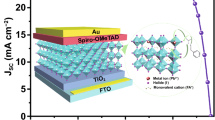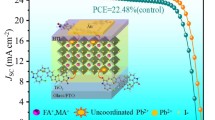Abstract
Hybrid organic–inorganic perovskite solar cells (PSCs) are promising new generations of solar cells, which is low in cost with high power conversion efficiency (PCE). However, PSCs suffer from structural defects generated from the under coordinated ions at the surface, which limits their photovoltaic performances. Herein we report, two β-diketone Lewis base additives 2,4-pentanedione and 3-methyl-2,4-nonanedione within the chlorobenzene anti-solvent to passivate the surface defects generated from the under coordinated Pb2+ ions in CH3NH3PbI3 perovskite films. The incorporation of the two β-diketone passivators could successfully enhance the open-circuit voltage of the PSCs by 52 mV and 17 mV for 3-methyl-2,4-nonanedione and 2,4-pentanedione, respectively, with improved PCE by 45% for 3-methyl-2,4-nonanedione compared to the pristine PSC. This enhancement in the photovoltaic performance of the PSCs can be attributed to passivation of the defects through the interaction between two carbonyl groups of the β-diketone Lewis base additives and the under coordinated Pb2+ defects in the perovskite film, which improved the PSCs PCE and stability.








Similar content being viewed by others
Data availability
All data used in this article are presented in the article and its electronic supplementary materials.
References
Kayesh, M. E., Matsuishi, K., Chowdhury, T. H., Kaneko, R., Lee, J.-J., Noda, T., et al. (2018). Influence of anti-solvents on CH3NH3PbI3 films surface morphology for fabricating efficient and stable inverted planar perovskite solar cells. Thin Solid Films, 663, 105–115.
Liu, S., Guan, Y., Sheng, Y., Hu, Y., Rong, Y., Mei, A., et al. (2020). A review on additives for halide perovskite solar cells. Advanced Energy Materials, 10(13), 1902492.
Abdel-Shakour, M., Chowdhury, T. H., Matsuishi, K., Bedja, I., Moritomo, Y., Islam, A., et al. (2020). High efficiency tin halide perovskite solar cells: the chemistry of tin (II) compounds and their interaction with Lewis base additives during perovskite film formation. Solar rrl, 5(1), 2000606.
Yuan, Y., & Huang, J. (2016). Ion migration in organometal trihalide perovskite and its impact on photovoltaic efficiency and stability. Accounts of Chemical Research, 49(2), 286–293.
Azpiroz, J. M., Mosconi, E., Bisquert, J., De Angelis, F. J. E., & Science, E. (2015). Defect migration in methylammonium lead iodide and its role in perovskite solar cell operation. Energy & Environmental Science, 8(7), 2118–2127.
Son, D.-Y., Lee, J.-W., Choi, Y. J., Jang, I.-H., Lee, S., Yoo, P. J., et al. (2016). Self-formed grain boundary healing layer for highly efficient CH3NH3PbI3 perovskite solar cells. Nature Energy, 1(7), 1–8.
Shao, Y., Xiao, Z., Bi, C., Yuan, Y., Huang, J., et al. (2014). Origin and elimination of photocurrent hysteresis by fullerene passivation in CH3NH3PbI3 planar heterojunction solar cells. Nature Communications, 5(1), 1–7.
Lin, Y., Shen, L., Dai, J., Deng, Y., Wu, Y., Bai, Y., et al. (2017). π-Conjugated Lewis Base: efficient trap-passivation and charge-extraction for hybrid perovskite solar cells. Advanced Materials, 29(7), 1604545.
Chen, B., Rudd, P. N., Yang, S., Yuan, Y., Huang, J., et al. (2019). Imperfections and their passivation in halide perovskite solar cells. Chemical Society Reviews, 48(14), 3842–3867.
Zhang, H., Wu, Y., Shen, C., Li, E., Yan, C., Zhang, W., et al. (2019). Efficient and stable chemical passivation on perovskite surface via bidentate anchoring. Advanced Energy Materials, 9(13), 1803573.
Tavakoli, M. M., Bi, D., Pan, L., Hagfeldt, A., Zakeeruddin, S. M., Grätzel, M., et al. (2018). Adamantanes enhance the photovoltaic performance and operational stability of perovskite solar cells by effective mitigation of interfacial defect states. Advanced Energy Materials, 8(19), 1800275.
Ono, L. K., Qi, Y., et al. (2016). Surface and interface aspects of organometal halide perovskite materials and solar cells. The Journal of Physical Chemistry Letters, 7(22), 4764–4794.
She, L., Liu, M., Zhong, D., et al. (2016). Atomic structures of CH3NH3PbI3 (001) surfaces. ACS Nano, 10(1), 1126–1131.
Noel, N. K., Abate, A., Stranks, S. D., Parrott, E. S., Burlakov, V. M., Goriely, A., et al. (2014). Enhanced photoluminescence and solar cell performance via Lewis base passivation of organic–inorganic lead halide perovskites. ACS Nano, 8(10), 9815–9821.
Zeng, Q., Zhang, X., Feng, X., Lu, S., Chen, Z., Yong, X., et al. (2018). Polymer-passivated inorganic cesium lead mixed-halide perovskites for stable and efficient solar cells with high open-circuit voltage over 1.3 V. Advanced Materials, 30(9), 1705393.
Wang, F., Geng, W., Zhou, Y., Fang, H. H., Tong, C. J., Loi, M. A., et al. (2016). Phenylalkylamine passivation of organolead halide perovskites enabling high-efficiency and air-stable photovoltaic cells. Advanced Materials, 28(45), 9986–9992.
Li, X., Chen, C. C., Cai, M., Hua, X., Xie, F., Liu, X., et al. (2018). Efficient passivation of hybrid perovskite solar cells using organic dyes with -COOH functional group. Advanced Energy Materials, 8(20), 1800715.
Cramer, R. E., Chudyk, M. A., et al. (1972). Studies of an acetylacetone complex of zinc perchlorate. Inorganic Chemistry, 12(5), 1193–1195.
Aromí, G., Gamez, P., & Reedijk, J. (2008). Poly beta-diketones: prime ligands to generate supramolecular metalloclusters. Coordination Chemistry Reviews, 252(8–9), 964–989.
Garra, P., Morlet-Savary, F., Graff, B., Dumur, F., Monnier, V., Dietlin, C., et al. (2018). Metal Acetylacetonate-Bidentate Ligand Interaction (MABLI) as highly efficient free radical generating systems for polymer synthesis. Polymer Chemistry, 9(12), 1371–1378.
Xie, L., Hwang, H., Kim, M., Kim, K., et al. (2017). Ternary solvent for CH3NH3PbI3 perovskite films with uniform domain size. Physical Chemistry Chemical Physics, 19(2), 1143–1150.
Radicchi, E., Mosconi, E., Elisei, F., Nunzi, F., De Angelis, F., et al. (2019). Understanding the solution chemistry of lead halide perovskites precursors. ACS Applied Energy Materials, 2(5), 3400–3409.
Niu, T., Lu, J., Munir, R., Li, J., Barrit, D., Zhang, X., et al. (2018). Stable high-performance perovskite solar cells via grain boundary passivation. Advanced Materials, 30(16), 1706576.
Huang, Z., Hu, X., Liu, C., Tan, L., Chen, Y., et al. (2017). Nucleation and crystallization control via polyurethane to enhance the bendability of perovskite solar cells with excellent device performance. Advanced Functional Materials, 27(41), 1703061.
Gfroerer, T., & theory, & instrumentation. (2006). Photoluminescence in analysis of surfaces and interfaces. Chichester: John Wiley & Sons Ltd.
Chaudhary, B., Kulkarni, A., Jena, A. K., Ikegami, M., Udagawa, Y., Kunugita, H., et al. (2017). Poly (4-Vinylpyridine)-Based interfacial passivation to enhance voltage and moisture stability of lead halide perovskite solar cells. Chemsuschem, 10(11), 2473–2479.
Kayesh, M. E., Chowdhury, T. H., Matsuishi, K., Kaneko, R., Kazaoui, S., Lee, J.-J., et al. (2018). Enhanced photovoltaic performance of FASnI3-based perovskite solar cells with hydrazinium chloride coadditive. ACS Energy Letters, 3(7), 1584–1589.
Gharibzadeh, S., Nejand, B. A., Moshaii, A., Mohammadian, N., Alizadeh, A. H., Mohammadpour, R., et al. (2016). Two-step physical deposition of a compact CuI Hole- Transport layer and the formation of an interfacial species in perovskite solar cells. Chemsuschem, 9(15), 1929–1937.
Liang, P. W., Liao, C. Y., Chueh, C. C., Zuo, F., Williams, S. T., Xin, X. K., et al. (2014). Additive enhanced crystallization of solution- processed perovskite for highly efficient planar-heterojunction solar cells. Advanced Materials, 26(22), 3748–3754.
Thakur, U., Kwon, U., Hasan, M. M., Yin, W., Kim, D., Ha, N. Y., et al. (2016). Investigation into the advantages of pure perovskite film without PbI2 for high performance solar cell. Scientific Reports, 6, 35994.
Wu, T., Wang, Y., Li, X., Wu, Y., Meng, X., Cui, D., et al. (2019). Efficient defect passivation for perovskite solar cells by controlling the electron density distribution of donor-π- acceptor molecules. Advanced Energy Materials, 9(17), 1803766.
Li, H., Li, Y., Li, Y., Shi, J., Zhang, H., Xu, X., et al. (2017). Synergistic effect of caprolactam as lewis base and interface engineering for efficient and stable planar perovskite solar cells. Nano Energy, 42, 222–231.
Zhuang, X., Zhang, Y., Zhang, J., Chen, Y., Zhu, Y., et al. (2018). The roles of acetylacetone additives in enhancing perovskite solar cell performance. Materials Research Express, 6(2), 025512.
Kamarudin, M. A., Hirotani, D., Wang, Z., Hamada, K., Nishimura, K., Shen, Q., et al. (2019). Suppression of charge carrier recombination in lead-free tin halide perovskite via Lewis base post-treatment. The Journal of Physical Chemistry Letters, 10(17), 5277–5283.
Hou, X., Huang, S., Ou-Yang, W., Pan, L., Sun, Z., Chen, X., et al. (2017). Constructing efficient and stable perovskite solar cells via interconnecting perovskite grains. ACS Applied Materials & Interfaces, 9(40), 35200–35208.
Pazos-Outón, L. M., Xiao, T. P., Yablonovitch, E., et al. (2018). Fundamental efficiency limit of lead iodide perovskite solar cells. The Journal of Physical Chemistry Letters, 9(7), 1703–1711.
Sherkar, T., Momblona, C. L., Gil-Escrig, J., Ávila, M. S., Bolink, H. J., Koster, L. J. A., et al. (2017). Recombination in perovskite solar cells: significance of grain boundaries, interface traps, and defect ions. ACS Energy Letters, 2, 1214.
Habisreutinger, S. N., Noel, N. K., Snaith, H., et al. (2018). Hysteresis index: A figure without merit for quantifying hysteresis in perovskite solar cells. ACS Energy Letters, 3(10), 2472–2476.
Wei, D., Ma, F., Wang, R., Dou, S., Cui, P., Huang, H., et al. (2018). Ion-Migration inhibition by the cation–π interaction in perovskite materials for efficient and stable perovskite solar cells. Advanced Materials, 30(31), 1707583.
Chen, J., Ko, S., Liu, L., Sheng, Y., Han, H., Li, X., et al. (2015). The effect of different alkyl chains on the photovoltaic performance of D–π–A porphyrin-sensitized solar cells. New Journal of Chemistry, 39(5), 3736–3746.
Acknowledgements
A.I. acknowledges the support from JSPS KAKENHI Grant no. 18H02079. M. A-S thanks the Egyptian Ministry of Higher Education & Scientific Research for the financial support through the Egypt-Japan Education Partnership (EJEP)-3rd call.
Author information
Authors and Affiliations
Corresponding author
Ethics declarations
Conflict of interests
The authors declared no competing interests.
Rights and permissions
About this article
Cite this article
Abdel-Shakour, M., Chowdhury, T.H., Matsuishi, K. et al. Chemical passivation of the under coordinated Pb2+ defects in inverted planar perovskite solar cells via β-diketone Lewis base additives. Photochem Photobiol Sci 20, 357–367 (2021). https://doi.org/10.1007/s43630-021-00023-z
Received:
Accepted:
Published:
Issue Date:
DOI: https://doi.org/10.1007/s43630-021-00023-z




